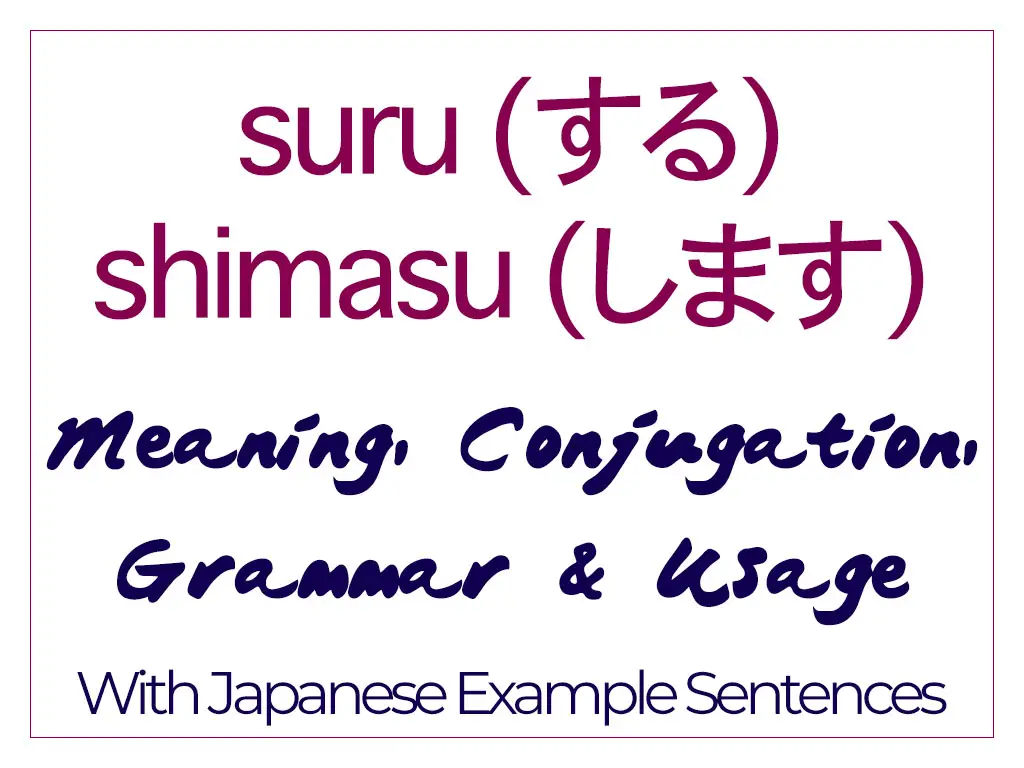Suru Te Form
Suru Te Form - The conjugations and english meanings are automatically generated and not all forms are always relevant for all verbs. Basically, it is known as the ‘te’ form because you change the verbs to end with the japanese ‘te’ (て) or ‘nde’ (んで). The following diagram shows the. This is for a guide. 50 rows conjugate the japanese verb する (suru) in all forms with usage examplesする conjugation has never been easier! We’ll teach you how to convert.
The following diagram shows the. We’ll teach you how to convert. 50 rows conjugate the japanese verb する (suru) in all forms with usage examplesする conjugation has never been easier! This is for a guide. Basically, it is known as the ‘te’ form because you change the verbs to end with the japanese ‘te’ (て) or ‘nde’ (んで). The conjugations and english meanings are automatically generated and not all forms are always relevant for all verbs.
The conjugations and english meanings are automatically generated and not all forms are always relevant for all verbs. The following diagram shows the. 50 rows conjugate the japanese verb する (suru) in all forms with usage examplesする conjugation has never been easier! Basically, it is known as the ‘te’ form because you change the verbs to end with the japanese ‘te’ (て) or ‘nde’ (んで). This is for a guide. We’ll teach you how to convert.
SET 2023 er form fillup suru YouTube
This is for a guide. We’ll teach you how to convert. 50 rows conjugate the japanese verb する (suru) in all forms with usage examplesする conjugation has never been easier! The conjugations and english meanings are automatically generated and not all forms are always relevant for all verbs. Basically, it is known as the ‘te’ form because you change the.
Suru on Toyhouse
This is for a guide. We’ll teach you how to convert. 50 rows conjugate the japanese verb する (suru) in all forms with usage examplesする conjugation has never been easier! Basically, it is known as the ‘te’ form because you change the verbs to end with the japanese ‘te’ (て) or ‘nde’ (んで). The following diagram shows the.
Japanese Upgrade with James creating the te form with the verbs “iku
Basically, it is known as the ‘te’ form because you change the verbs to end with the japanese ‘te’ (て) or ‘nde’ (んで). We’ll teach you how to convert. This is for a guide. The following diagram shows the. The conjugations and english meanings are automatically generated and not all forms are always relevant for all verbs.
【GENKI L6】What is TE Form? How to use Japanese TE Form YouTube
The conjugations and english meanings are automatically generated and not all forms are always relevant for all verbs. The following diagram shows the. 50 rows conjugate the japanese verb する (suru) in all forms with usage examplesする conjugation has never been easier! Basically, it is known as the ‘te’ form because you change the verbs to end with the japanese.
Conjugating TeForm in Japanese Handy Illustrated Howto Guide!
The conjugations and english meanings are automatically generated and not all forms are always relevant for all verbs. We’ll teach you how to convert. 50 rows conjugate the japanese verb する (suru) in all forms with usage examplesする conjugation has never been easier! This is for a guide. Basically, it is known as the ‘te’ form because you change the.
Te form Japanische grammatik, Japanisch lernen, Japan
The conjugations and english meanings are automatically generated and not all forms are always relevant for all verbs. This is for a guide. The following diagram shows the. We’ll teach you how to convert. Basically, it is known as the ‘te’ form because you change the verbs to end with the japanese ‘te’ (て) or ‘nde’ (んで).
Japanese Language Japanese Verbs
The following diagram shows the. 50 rows conjugate the japanese verb する (suru) in all forms with usage examplesする conjugation has never been easier! This is for a guide. Basically, it is known as the ‘te’ form because you change the verbs to end with the japanese ‘te’ (て) or ‘nde’ (んで). We’ll teach you how to convert.
Suru (する) Meaning, Conjugation, Japanese Examples AlexRockinJapanese
Basically, it is known as the ‘te’ form because you change the verbs to end with the japanese ‘te’ (て) or ‘nde’ (んで). We’ll teach you how to convert. 50 rows conjugate the japanese verb する (suru) in all forms with usage examplesする conjugation has never been easier! The following diagram shows the. This is for a guide.
Suru on Toyhouse
We’ll teach you how to convert. 50 rows conjugate the japanese verb する (suru) in all forms with usage examplesする conjugation has never been easier! Basically, it is known as the ‘te’ form because you change the verbs to end with the japanese ‘te’ (て) or ‘nde’ (んで). This is for a guide. The conjugations and english meanings are automatically.
【Japanese】Verb Te form(て形)about conversion rule from masuform to te
The conjugations and english meanings are automatically generated and not all forms are always relevant for all verbs. Basically, it is known as the ‘te’ form because you change the verbs to end with the japanese ‘te’ (て) or ‘nde’ (んで). 50 rows conjugate the japanese verb する (suru) in all forms with usage examplesする conjugation has never been easier!.
The Conjugations And English Meanings Are Automatically Generated And Not All Forms Are Always Relevant For All Verbs.
50 rows conjugate the japanese verb する (suru) in all forms with usage examplesする conjugation has never been easier! This is for a guide. We’ll teach you how to convert. The following diagram shows the.








